Medinet Madi (Madinat Madi) in the Fayoum of Egypt
by Joerg Reid

It is likely that the typical tourist to Egypt will not, on their first visit, tour the Fayoum region, though for those interested in nature, or fossils, perhaps they should. However, for the antiquities enthusiast, there is simply too many other, perhaps somewhat more convenient sights to see, and the Fayoum is not particularly well promoted by tour operators. Yet, the Fayoum does offer many important historical monuments. Many of these date from the Graeco-Roman Period, though others are much older, including Medinet Madi, which many consider to be one of the most important temples in the Fayoum.

An overview of some of the ruins at Medinet Madi in the Fayoum of Egypt


Situated about 30 kilometers southwest of Medinet el-Fayoum, Medinet Madi, which means "City of the Past", was during the Graeco-Roman Period known as Narmouthis (City of Renenutet). It was first recorded in modern times by Napoleon's expedition to Egypt. Grenfell and Hunt were aware of its existence but did no excavations. Early in the 20th century, Jouguet investigated the site and he was the first to suggest that it consisted of two distinct towns, one measuring forty thousand square meters situated on an eastern kom, and another, some three or four times as large, on a western kom. German archaeologists began work there in 1910, but the war interrupted those efforts and the concession was later taken over by the University of Milan.
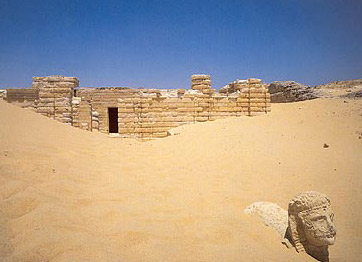
During the first season of excavation under the Milan team directed by A. Vogliano, the remains of a temple dedicated to Isis Hermouthis, the Greek version of Renenutet was unearthed. Though later transferred to the Greco-Roman Museum in Alexandria, pilasters incorporated into the temple structure were inscribed with Greek hymns to this goddess. However, one line in one of the hymns also referred to an earlier Middle Kingdom temple on the site dedicated by Amenemhet III. That now famous temple was later unearthed in the second excavation campaign. Also uncovered from the sand was a second Ptolemaic temple, back to back with the Middle Kingdom one. However, this series of excavations only lasted for two additional seasons. Afterwards, it was not until 1966, under the direction of Dr. Edda Bresciani that excavations resumed.
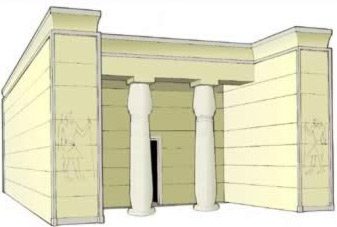
Today, the most interesting structure is of course the southern facing Middle Kingdom temple with its Ptolemaic addition, located just over a mound beyond the Italians' old dig house. Though there is little left of this building, and though everywhere there is debris, what does remain of the temple is fairly well preserved. Every so often, the antiquity authorities must come along and clean out the sand, but typically one can see, from the top of the mound, the processional way which is part of the Ptolemaic construct, flanked by sphinxes and lions and these days, a considerable amount of other Ptolemaic Period construction. The human headed ones probably portray the facial features of one of the Ptolemaic kings. On the right side of the entrance portal is a smiling lion with crossed paws, while the inner left wall is engraved with the relief of a goddess, probably Hermouthis, suckling her son.
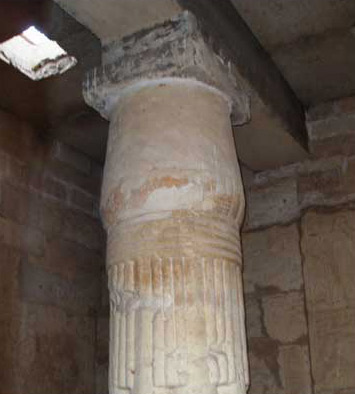
Made of dark sandstone, the inner two rooms of the Middle Kingdom structure are roofed and intact, and thus are extremely rare examples of Middle Kingdom monumental building. Indeed, this is one of the few buildings that allows the visitor to sense a sanctuary as it was seen by the ancient priests. This temple was dedicated to Sobek and his consort Renenutet (a protector of the harvest and granaries), along with their son, a form of Horus. These depictions of Renenutet are very rare. Inside there are representations of Amenemhet III and his son, Amenemhet IV who finished the temple, making offerings to Sobek and Renenutet. Many of the hieroglyphic inscriptions remain on the walls, and though faint, often can still be read. All of the inscriptions on the western side of the temple belong to Amenemhet III, while those on the eastern wall are those of this son.
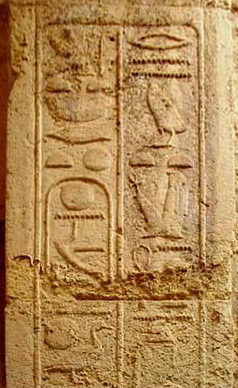
This part of the temple is in fact rather small, with a columned hall, or probably more precisely, a two Papyrus columned portico leading into a sanctuary with three shrines (niches really) occupying the rear. The two large papyriform columns in the first room have identical inscriptions to Renenutet, except that the column on the left bears the two names of Amenemhet III, while that on the right belong to Amenemhet IV.
On the wall on the left side of this room is a relief depicting the purification of the king. Here, the god Sobek, recognizable by his crocodile snout, stands before the king while Anubis stands behind the king. The two gods pour purifying water over the king's head. As we see in other such reliefs, the drops of water take the form of the ankh, the hieroglyphic symbol of life. The inscription here is still legible, and can be translated as, "You will be purified, and your "ka" purified, with the water of life."
There is a small corridor that leads to the second and last room. The walls of the corridor are inscribed with a dedicatory formula to the goddess Renenutet. Very interestingly, just inside this inner chamber, on both sides of the doorway, is another dedicatory inscription to the goddess Renenutet, though here, for reasons rather unknown, the name of Amenemhat inside the cartouche has been defaced.

This inner chamber of the oldest part of the temple complex is dominated by the three large niches recessed into the back wall. The niche on the left (west) contains a scene depicting the pharaoh offering unguent molded into a conical shape to the goddess Renenutet. In this rendition of Renenutet, one can clearly see her serpent's head. Far from appearing grotesque, the image is quite graceful with the cobra hood adorning her shoulders like a coiffure. On the opposing wall is a scene of him making offerings to Sobek. Similar offering scenes adorn the walls of the other niches, which were meant to hold statue groups representing Renenutet flanked by the two kings. Indeed, in the largest, center niche are the remains of such a group.
Notably, the probable wife of Amenemhet III and mother of Amenemhet IV, Hetepti, is so far only known from this temple. The temple was restored during the 19th Dynasty. To the east of the temple there are also mudbrick storerooms and other foundations.

The small, Ptolemaic temple that lies back to back with the Middle Kingdom temple is its more modern counterpart. It was probably Ptolemy IX Soter II who added the two courtyards that lead to the central chapel containing an altar and flanking it are two smaller chapels. Here, we find stone doorways and lintels. The Greek inscriptions are badly worn and for the most part unreadable. The best preserved relief is found on the outer left wall as one enters the interior courtyard. Here, a delightful, grinning Sobek is depicted with a frightful set of teeth.
The Ptolemaic expansion of the temple included the processional way to the south with its lions and sphinxes (in both Egyptian and Greek style), which passed through a columned kiosk which eventually leads to the older two columned portico. A kiosk with eight columns once existed along the processional route.

Very recently in 1995, the Italian team from Pisa and Messina University that has been excavating this site since 1966 also discovered a Ptolemaic gate to the east of the temple and on further investigation another temple dedicated to Sobek was discovered beneath the rubble. This second temple was built of mudbrick with stone doorways and lintels, with its axis at right-angles to the older temple. Tablets and papyri were also found in the debris, including an important oracular document written in demotic script. Apparently, in 1930, a number of texts of some importance (known as A Manichaean Psalm-Book, Part II) were also discovered in this general location by Carl Schmidt which are thought to date from about 340 AD.

The team has also recently excavated a vaulted structure on the north side of the new temple, but the remains are poorly preserved. On the north side of the temple court, a crocodile nursery was discovered with dozens of eggs in different stages of maturation.
The Italian team, which is working to construct a three dimensional model of the monuments in the area in order to explore the chronological development of the site from the Middle Kingdom through the Greek and Roman periods, has also uncovered a large Roman town and ten Christian churches of the sixth and seventh century, indicating that the site saw activity perhaps well at least through Roman times. .

This most prominent ancient town is located on a small hill commanding a strategic position guarding the southwestern entrance to the Fayoum, and was probably occupied even as early as the prehistoric period.
We do not know what happened to spell the end of ancient Medinet Madi. It seems to have simply been abandoned, even though it clearly had a presence up into the Christian era and beyond. A medieval romance poem known as the "Story of Abu Zayd", which was often told in coffee shops throughout the Middle East even outside of Egypt, relates that Medinet Madi was destroyed by a popular semi-fictional war hero named Abu Zeid. It is said that he led his tribes from the desert of Nejd through Egypt on his way to Tunisia in the eleventh century AD. On their way, they passed through the ancient town located at Medinet Madi and asked the ruler, King Madi, for food and shelter. Unfortunately for Madi, he refused, so Abu Zed razed the town, killed the king and all of his subjects, and took what food and shelter he needed.
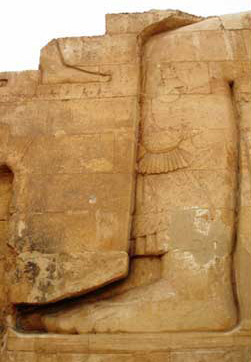
From the rise above the temples there are good views of the Fayoum basin to the east, the Gharaq basin to the south, and the bare desert to the north and west. The temple is one of the most isolated and romantic sites in the Fayoum region. This is one of the hardest sites to reach in the Fayoum, but tourists who make the effort will very often find themselves with a monument all to their own and plenty of time to look about. A guide is recommended.
References:
| Title | Author | Date | Publisher | Reference Number |
| Atlas of Ancient Egypt | Baines, John; Malek, Jaromir | 1980 | Les Livres De France | None Stated |
| Complete Temples of Ancient Egypt, The | Wilkinson, Richard H. | 2000 | Thames and Hudson, Ltd | ISBN 0-500-05100-3 |
| Egypt | Various | 1994 | Alfred A. Knopf, Inc. | ISBN 0-679-75566-7 |
| Fayoum, The | Hewison, R. Neil | 2001 | American University in Cairo press, The | ISBN 977 424 671 3 |
| Guide to the Antiquities of the Fayyum, A | Mary-Ellen Lane | 1985 | American University in Cairo Press, The | ISBN 947 424 042 1 |
| Western Desert of Egypt, The | Vivian, Cassandra | 2000 | American University in Cairo Press, The | ISBN 977 424 527 X |

